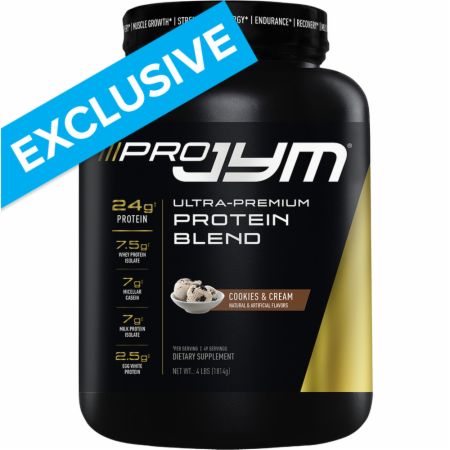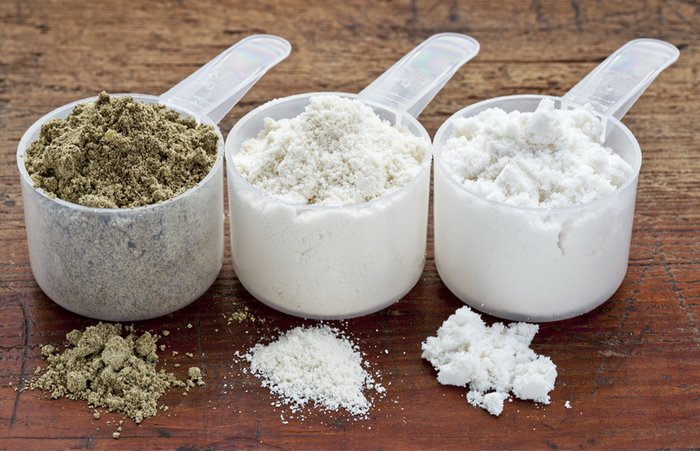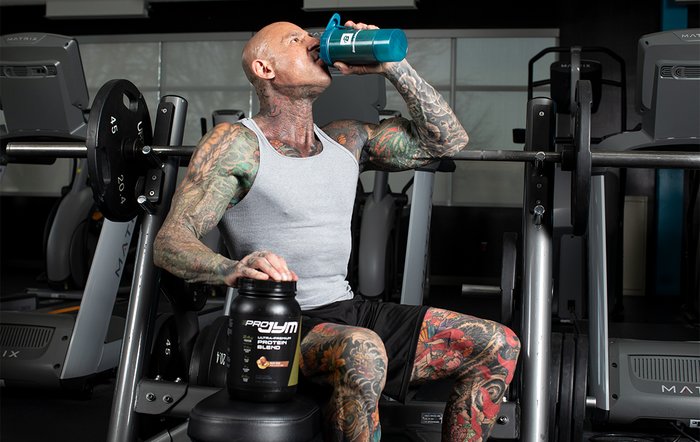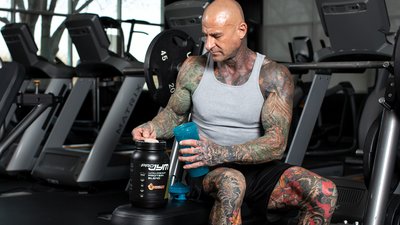Whey protein powder is as close as it gets to a "required supplement" for anyone looking to build muscle, gain a performance edge, support weight loss, or enhance overall health and wellness.
Whey does everything for you, it seems, short of dragging you to the gym and unracking the barbell.
So, how does it work? How much is enough? And should you be using it?
Yes, is the simple answer to the third question. The first two, however, will require some explaining. So, let's unscrew the cap on everyone's favorite protein supplement and take a closer look at the wonders of whey protein.
Where Whey Comes From
Whey protein itself is extremely common. In fact, you've probably been using it since childhood. Don't worry, nobody spiked your Cheerios. Along with casein, whey is actually one of the two proteins found in cow's milk. Casein accounts for about 80 percent of milk protein, and whey accounts for the remaining 20 percent.
Ever opened a yogurt container and found a clear liquid floating on top? Yup, that's whey. Don't go slurping yogurt-juice by the spoonful, though; this isn't the protein you've heard so much about. Not yet, anyway.
To make whey protein powder, the good stuff, whey first needs to be extracted from milk. Ever eaten a chunk of cheddar? Cheese manufacturers do the same thing as supplement makers: they separate whey from milk solids. In fact, long before anyone understood the benefits of whey, cheese manufacturers considered it useless and dumped tons down the drain.
Once whey has been extracted and isolated, it's filtered to remove fat and carbohydrates. What's left is the protein you love. Then, the more it's filtered, the purer the protein becomes. As filtering and protein content increase, carbs and fat decrease. While this sounds simple, I wouldn't start pouring yogurt run-off into your Brita. The processing required to make whey protein is a bit more advanced.

The Three Types of Whey Protein
There are basically three major types of whey protein. Each reflects a different degree of filtering and processing. From the least processed to the most processed, the types of whey are whey protein concentrate, whey protein isolate, and whey protein hydrolysate.
Whey protein concentrate goes through minimal processing. As a result, it's often much cheaper than other forms, making it a good choice for those on a budget.
Whey protein concentrate is made with gentle filtration processes known as micro- and ultrafiltration. These processes create a supplement that is around 70-80 percent protein, with the remainder being carbs and fat.
These processes also retain most of the beneficial peptide fractions, which are small particles of protein that perform various functions in the body. For example, whey peptides provide helpful antioxidant benefits.
Whey protein isolate (WPI) is more protein-packed than concentrate. Isolate is made with longer filtration times or additional types of processing, such as cross-flow microfiltration or ion-exchange chromatography. These fancy methods basically make a more protein-packed powder.

"Of course, many protein manufacturers combine two or even all three types of whey proteins into one powder so you benefit from each form."
Because of the additional processing, whey protein isolate often has protein concentrations higher than 95 percent. Isolate is thus a great choice for dieters because of its extremely low carb and fat content. It's also perfect for pre- and post-workout since it's digested and absorbed quickly.
Whey protein hydrolysate (WPH) is the most highly processed of all the whey proteins.
Therefore, it's often the most expensive. It's produced through a process called hydrolysis, which breaks longer whey protein chains into smaller peptide fragments.
Hydrolysis basically pre-digests whey protein, which makes the protein easier for the body to utilize. Because it's broken down and pre-digested, WPH is digested and absorbed even faster than whey protein isolate, making it the ideal protein powder around your workouts.
Of course, many protein manufacturers combine two, or even all three, of these whey proteins into one powder so you benefit from each form. When buying a new protein powder, check the ingredient label before dropping your dollars.
Research On Whey Protein
Regardless of which form you use, pure or blended, concentrate or hydrolyzed, whey protein is undoubtedly the king of protein supplements. There's a hulking body of research that suggests whey is better at stimulating muscle protein synthesis—the process that ultimately produces bigger and stronger muscles—than soy or casein. (Taking a casein protein shake is a solid way to raise your protein intake, but it doesn't hit your system as fast as whey protein, so it's not as powerful as a post-workout muscle mass booster.)
Whey is a fantastic muscle-builder for several reasons. The first is its rapid rate of digestion. Whey is the fastest-digesting protein powder you can buy. Once the protein shake is down your gullet, its amino acids (the building blocks of all proteins) break down rapidly and are absorbed into the bloodstream. Your blood then escorts these amino acids to muscle tissue, where they can quickly ignite protein synthesis.
In 1997, French researchers published a landmark study about whey's potent ability to stimulate muscle protein synthesis.[1] Researchers reported that when subjects increased their protein intake by consuming a whey protein drink, protein synthesis increased by almost 70 percent. However, when subjects consumed a casein protein drink, protein synthesis increased by only 30 percent. Scientists attributed this dramatic increase to whey's rapid rate of digestion.
Furthermore, whey boosts protein synthesis effectively because it's an extremely rich source of the branched-chain amino acids leucine, isoleucine, and valine. Leucine is the real MVP in this bunch. Research suggests that it acts much like the key to your car, turning on the powerful engine of protein synthesis.[2]
Whey protein also boosts blood flow to muscle tissue, which is another secret to its protein-synthesis power. Increased blood flow enhances the delivery of nutrients, including glucose (energy), amino acids, and oxygen. These nutrients support muscle growth and spur recovery after a workout.

A study reported that male bodybuilders supplementing with whey protein while following a 10-week weight-training program gained an average of 11 pounds of muscle, while those supplementing with casein protein gained barely 2 pounds.[3] The bodybuilders taking whey protein also experienced greater strength gains.
Whey Protein For Weight Loss
Whey is not only a powerful muscle-builder, it can also support weight loss. In fact, a study from the USDA reported that men and women drinking two whey protein shakes per day for 12 weeks (without dieting or exercising!) lost 5 pounds of body fat, dropped an inch from their waists and even gained muscle.[4] Those drinking a similar amount of soy protein, however, didn't see any positive changes in body composition.
How To Supplement With Whey
Wondering how to add this miracle powder to your diet? The two most important times to consume whey protein are 15-30 minutes before your workouts and within 30 minutes post-workout. Again, this goes back to its speedy digestion rate.
Providing a fast stream of amino acids to muscle tissue before, during, and immediately after resistance training promotes max muscle growth. Whole-food protein sources like chicken breast, eggs, fish, and beef won't digest fast enough to be beneficial during these critical times.
Before weight training, take about 10-20 grams of whey protein to enhance muscle strength, increase endurance, and decrease muscle breakdown. After your workouts, go with another 20-40 grams of protein powder to enhance muscle recovery and boost muscle protein synthesis.
You should also consider taking 20-40 grams of whey protein as soon as you roll out of bed. This will stop the muscle breakdown that occurs as a result of fasting overnight. Additionally, you can drink 20-40 grams in a protein shake as a snack between meals to boost muscle growth and support fat loss.

"Before weight training, take about 10-20 grams of whey protein to enhance muscle strength, increase endurance, and decrease muscle breakdown."
Wrapping Up
No matter your goals, whey protein can help. It's one of the first supplements you should consider—if not the first—when starting a muscle-building or fat-loss program.
To get the results you want, you can't ignore training, you can't forget proper nutrition, and you can't neglect your whey.
Jim Stoppani's Whey Protein Stack
- Pro Jym: Jim Stoppani's science-backed whey protein powder.
- Pre Jym: Energy and focus for your workout.
- Post Jym: Post-workout recovery optimizer.
- Vita Jym: Daily muscle-building nutrients you might be missing.
- Omega Jym: Omega-3 fatty acid supplement developed for athletes and lifters.
References
- Boirie, Y., Dangin, M., Gachon, P., Vasson, M. P., Maubois, J. L., & Beaufrère, B. (1997). Slow and fast dietary proteins differently modulate postprandial protein accretion. Proceedings of the National Academy of Sciences, 94(26), 14930-14935.
- Anthony, J. C., Anthony, T. G., Kimball, S. R., & Jefferson, L. S. (2001). Signaling pathways involved in translational control of protein synthesis in skeletal muscle by leucine. The Journal of Nutrition, 131(3), 856S-860S.
- Cribb, P. J., Williams, A. D., Carey, M. F., & Hayes, A. (2006). The effect of whey isolate and resistance training on strength, body composition, and plasma glutamine. International Journal of Sport Nutrition and Exercise Metabolism, 16(5), 494-509.
- Baer, D. J., Stote, K. S., Paul, D. R., Harris, G. K., Rumpler, W. V., & Clevidence, B. A. (2011). Whey Protein but Not Soy Protein Supplementation Alters Body Weight and Composition in Free-Living Overweight and Obese Adults, 2. The Journal of Nutrition, 141(8), 1489-1494.

